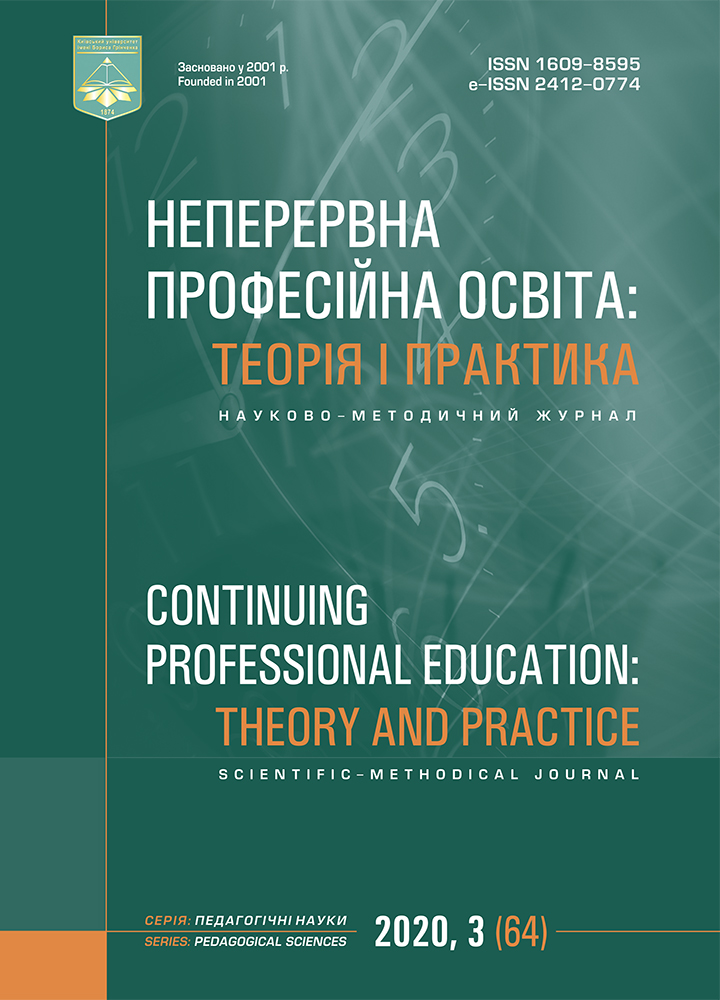IMPROVEMENT OF THE CONTENT OF PROFESSIONAL ACTIVITY OF SPECIALISTS INCLUSIVE EDUCATIONAL INSTITUTIONS: THE OCCUPATIONAL THERAPY APPROACH
DOI:
https://doi.org/10.28925/1609-8595.2020.3.1Keywords:
evidence based practice, inclusive education, multidisciplinary support, occupational therapy approach, special educational needsAbstract
The article addresses the issue of the effectiveness of intervention strategies to prepare children with special educational needs for inclusive learning. It was determined that the occupational therapy approach takes into account a system of factors that can fundamentally improve the methodological foundations and practical guidelines for the activities of specialists in an inclusive environment.
This system of factors covers interconnected components: 1) patterns of stages of sequential development of the child and creating a step-by-step intervention program; 2) modification of the child’s living environment so that it becomes stimulating and developing; 3) partnership of the occupational therapist with other IEP team members of, which provides for a joint determination of his needs, the formulation of SMART goals, its coordinated achievement, peer monitoring and appropriate adjustment of goals.
We present in the article a comparative analysis of areas of responsibility and features of the occupational therapist and sensory therapist as a specialist, which partially duplicates the functions of an occupational therapist. The importance of distinguishing between them helps to determine the responsible position of the practices from the irresponsible one and to formulate guidelines for successful support of children with special needs.
We have developed a model for creating the prerequisites for inclusive education for children with special needs, relying on the following criteria for an occupational therapy approach, such as systematic, resourceful, collegial, technological and evidence-based effectiveness. The scientific evidence of an occupational therapy approach is disclosed, as well as the technological aspect of the presented model of intervention in the direction of preparing a child with special educational needs for the educational process.
References
Ayres, A. (2013). Rebenok i sensornaya integraciya. Ponimanie skrytyh problem razvitiya [Sensory Integration and the Child]. Terevinf.
Bernshtejn, N. A. (2004). Biomehanika i fiziologiya dvizhenij: izbrannye psihologicheskie trudy [Biomechanics and physiology of movements: selected psychological works]. MODEK.
Zakon Ukrayini Pro ratifikaciyu Konvenciyi pro prava osib z invalidnistyu vid 16.12.2009 № 1767-VI [Law of Ukraine on Ratification of the Convention on the Rights of Persons with Disabilities of 16.12.2009 № 1767-VI]. http://search. ligazakon.ua/l_doc2.nsf/link1/T091767.html.
Maksimova. E. V. (2015). Urovni obsheniya: prichiny vozniknoveniya rannego detskogo autizma i ego korrekciya na osnove teorii N. A. Bernshtejna [Levels of communication: the causes of early childhood autism and its correction based on the theory of N. A. Bernstein]. Dialog-MIFI.
Skrypnyk, T. V. (2019). Diti z autizmom v inklyuziyi: scenariyi uspihu: monografiya [Children with autism in inclusion: scenarios of success: a monograph]. KUBG.
Skrypnyk, T. V. (2017). Sensorna integraciya yak pidgruntya cilisnogo rozvitku ditej z autizmom [Sensory integration as the basis of a integrated development of children with autism]. Osobliva ditina: navchannya i vihovannya, 80 (4), 24–31.
Smolyaninov, A., Vancova, A. (2011). Ruka – mozg [Hand – brain]. EPSYNEL.
Ayres, A. J. (1975). Sensorimotor foundations of academic ability. In W. M. Cruickshank, D. P. Hallahan (Eds.), Perceptual and Learning Disabilities in Children (pp. 301–358). Syracuse University Press.
Ayres, J. (1983). Sensory integration and learning disorders. Western Psychological Services.
Beaudry-Bellefeuille, I., Lane, S. J., Lane, А. Е. (2019). Sensory Integration Concerns in Children With Functional Defecation Disorders: A Scoping Review. American Journal of Occupational Therapy, 73 (3), 7303205050– 7303205050. https://doi.org/10.5014/ajot.2019.030387.
Crowell, С. С., Mora-Guiard, J., Pares, N. (2018). Impact of Interaction Paradigms on Full-Body Interaction Collocated Experiences for Promoting Social Initiation and Collaboration. Human-Computer Interaction, 33 (5–6), 422–454. https://doi.org/10.1080/07370024.2017.1374185.
D’Arrigo, R. G., Copley, J. A., Jodie, A., Poulsen, A. A., Ziviani, J. (2020). Strategies occupational therapists use to engage children and parents in therapy sessions. Australian occupational therapy journal. DOI: 10.1111/1440-1630.12670.
Kalmbach, D., Wood, W., Peters , B . C. (2020). Parental Perspectives of Occupational Therapy in an Equine Environment for Children with Autism Spectrum Disorder. Occupational therapy in health care. DOI: 10.1080/07380577.2020.1751903.
Kilroy, E., Aziz-Zadeh, L., Cermak, S. (2019). Ayres Theories of Autism and Sensory Integration Revisited: What Contemporary Neuroscience Has to Say. Brain Sciences, 9 (3). 68. 10.3390/brainsci9030068.
Kramer-Roy, D., Hashim, D., Tahir, N., Khan, A., Khalid, A., Faiz, N., Minai, R., Jawaid, S., Khan, S., Rashid, R. (2020).
The developing role of occupational therapists in school-based practice: Experiences from collaborative action research in Pakistan. British journal of occupational therapy, 83 (6), 375–386. DOI: 10.1177/0308022619891841.
Mailloux, Z., Mulligan, S., Roley, S. S., Blanche, E., Cermak, S., Coleman, G. G., Bodison, S., Lane, C. J. ( 2011).
Verification and clarification of patterns of sensory integrative dysfunction. American Journal of Occupational Therapy, 65 (2), 143–151. 10.5014/ajot.2011.000752.
Schaaf, R. C., Dumont, R. L., Arbesman, M., May-Benson, T. A. (2017). Efficacy of occupational therapy using Ayres Sensory Integration ®: A systematic review. American Journal of Occupational Therapy, 72. 10.5014/ ajot.2018.028431.
Schoen, S. A., Lane, S. J., Schaaf, R. C., Mailloux, Z., Parham, L. D., May-Benson, T., Roley, S. S. (2019). Ayres Sensory Integration Meets Criteria for an Evidence-Based Practice: A Response to Stevenson. Autism Research, 12 (8), 1154–1155. 10.1002/aur.2164.
Watling, R., Hauer, S. (2015). Effectiveness of Ayres Sensory Integration ® and Sensory-Based Interventions for People with Autism Spectrum Disorder: A Systematic Review. American Journal of Occupational Therapy, 69. 10.5014/ajot.2015.018051.
Downloads
Published
How to Cite
Issue
Section
License
Copyright (c) 2020 Tetiana Skrypnyk

This work is licensed under a Creative Commons Attribution-NonCommercial 3.0 Unported License.



